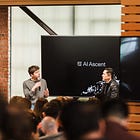Sequoia AI Ascent: lessons by OpenAI, Nvidia, Anthropic, LangChain and Ramp
Inside Sequoia’s AI Ascent: The Most Actionable Insights for Founders from Nvidia, OpenAI, LangChain, and Ramp
Hey everyone, my name is Guillermo Flor and I’m an entrepreneur and Venture Capitalist.
Last week Sequoia hosted AI Ascent, a private event that brought together some of the sharpest min
I spent the whole weekend studying it, dividing it in 2 parts:
1. Where the Partners at Sequoia see the biggest opportunity in AI is rigth now
2. The State of AI according …
Keep reading with a 7-day free trial
Subscribe to The AI Opportunity to keep reading this post and get 7 days of free access to the full post archives.



